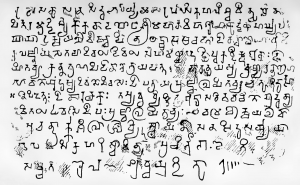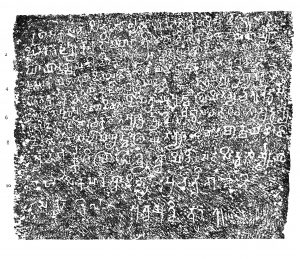

Perfection has been attained! By the Upâsikâ Harisvâminyî, the wife of the Upâsakâ Sanasiddha, for the sake of (her) parents, twelve dînâras are given, (as) a permanent endowment, to the community of the faithful, collected from the four quarters of the world, at the holy great vihâra of Kâkanâdabôṭa. With the interest that accrues of these dînâras, day by day one Bhikshu, who has been introduced into the community, should be fed.
(Line 5.)—Also, three dînâras are given in the jewel-house. With the interest of these three dînâras, day by day a lamp of the divine Buddha should be lit in the jewel-house.
(L. 6.)— Also, one dînâra is given in the place where (the images of) the four Buddhas are seated. With the interest of this, day by day a lamp of the divine Buddha should be lit in the place where (the images of) the four Buddhas are seated.
(L. 8.)— Thus this permanent endowment, —written upon stone (so as to endure) for the same time with the moon and the sun, —has been accomplished by the Upâsikâ Harisvâminyî, the noble lady, the wife of Sanasiddha.
(L. 11.)— The year 100 (and) 30 (and) 1; (the month) Aśvayuj; the day 5.